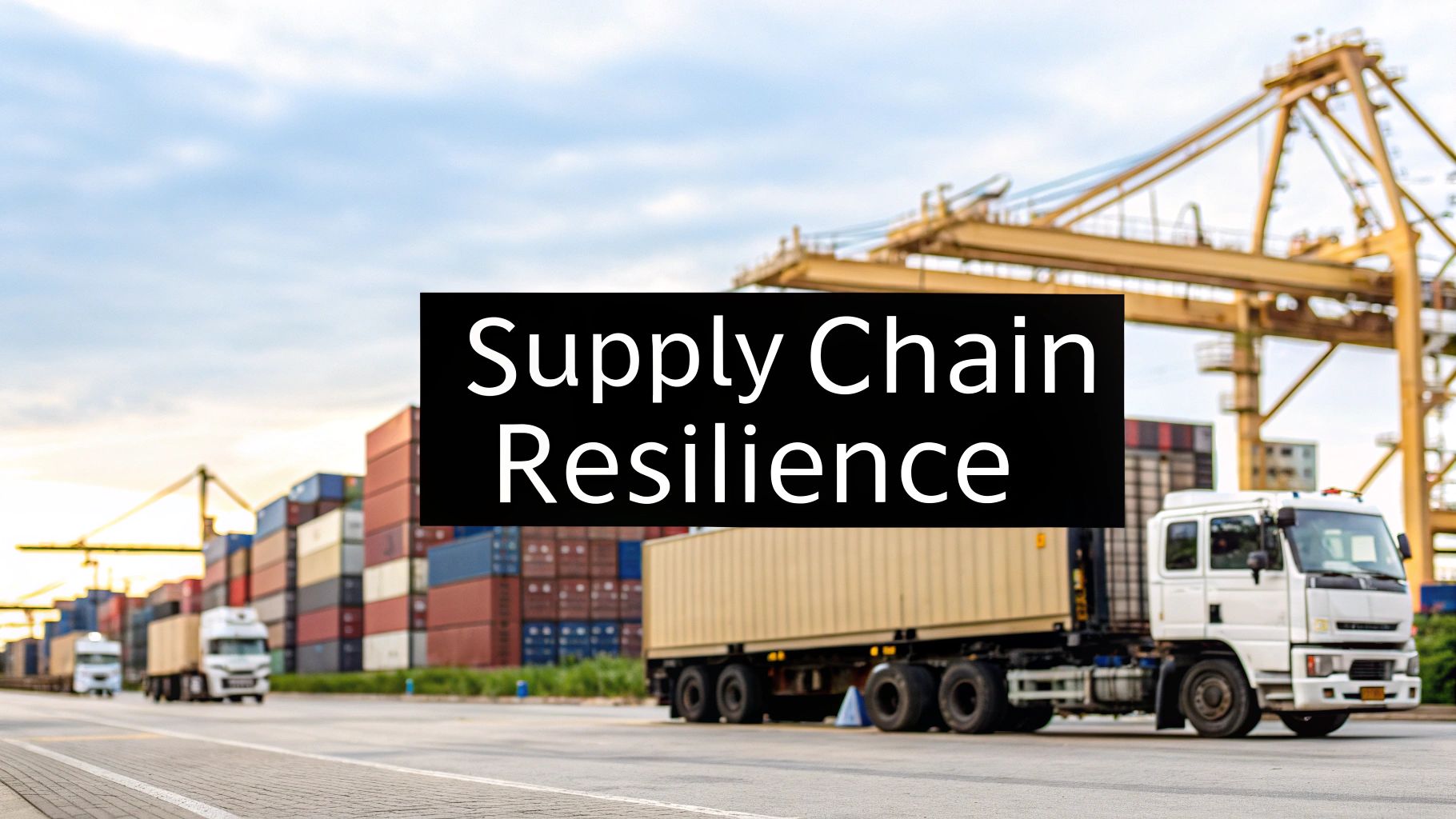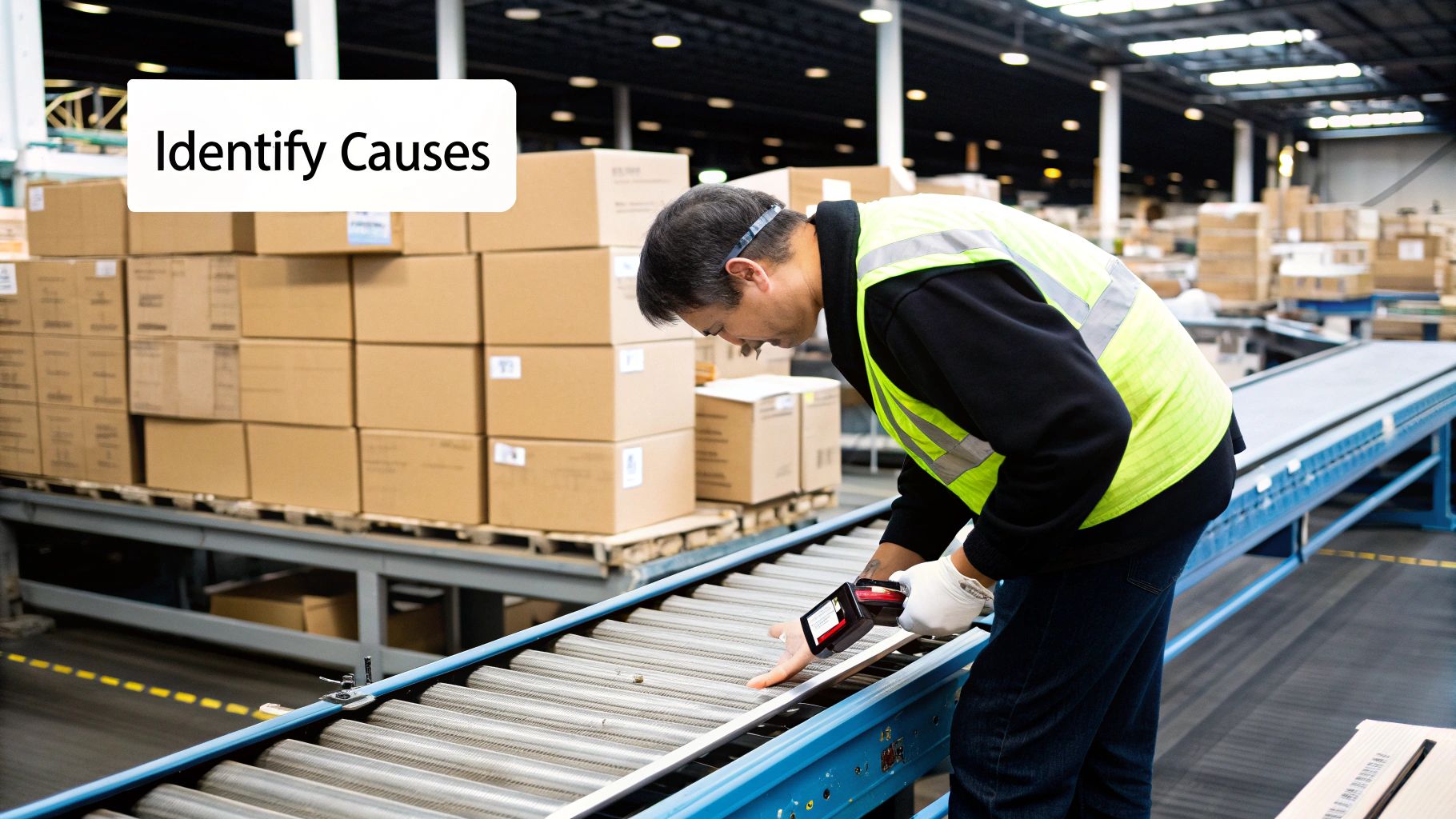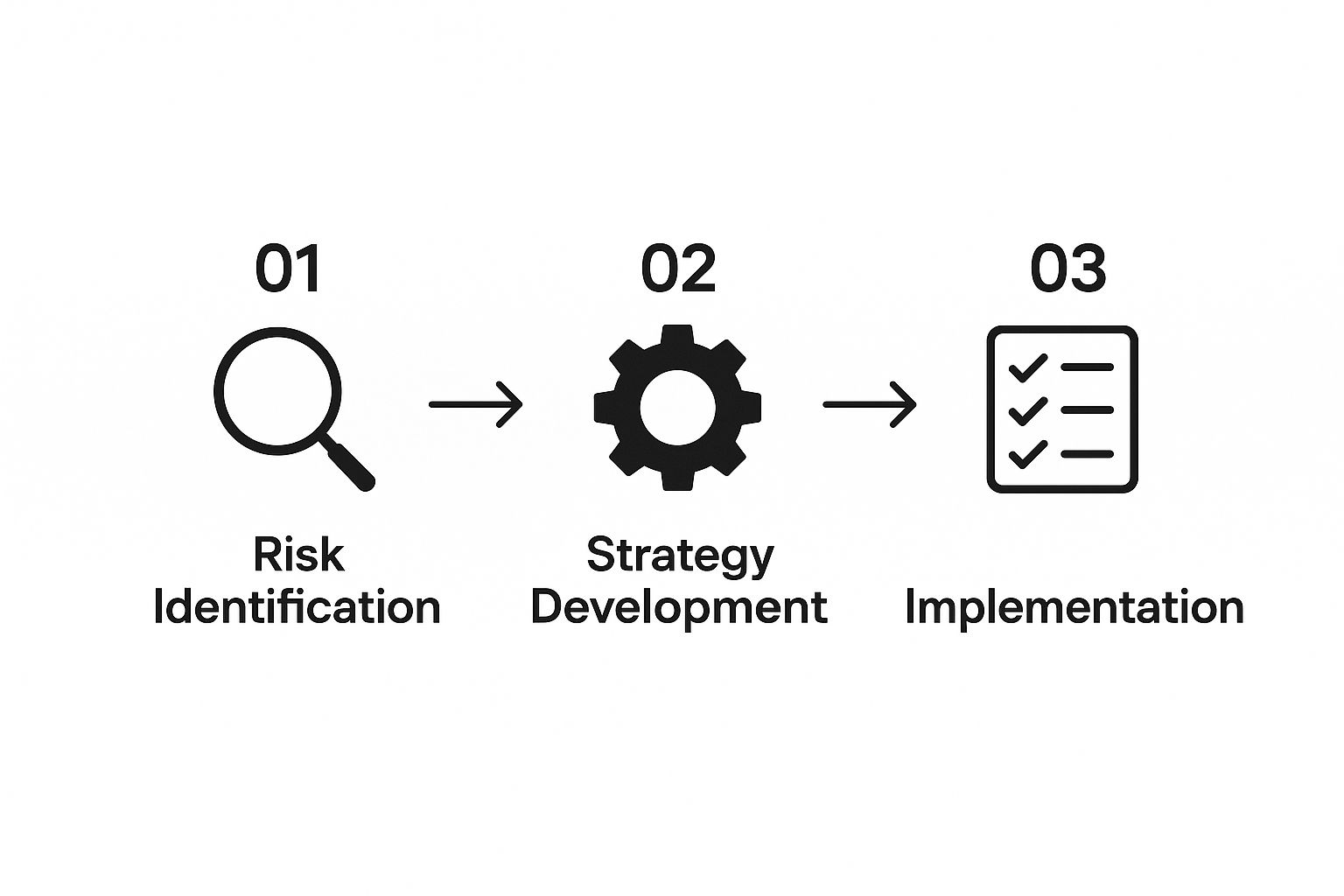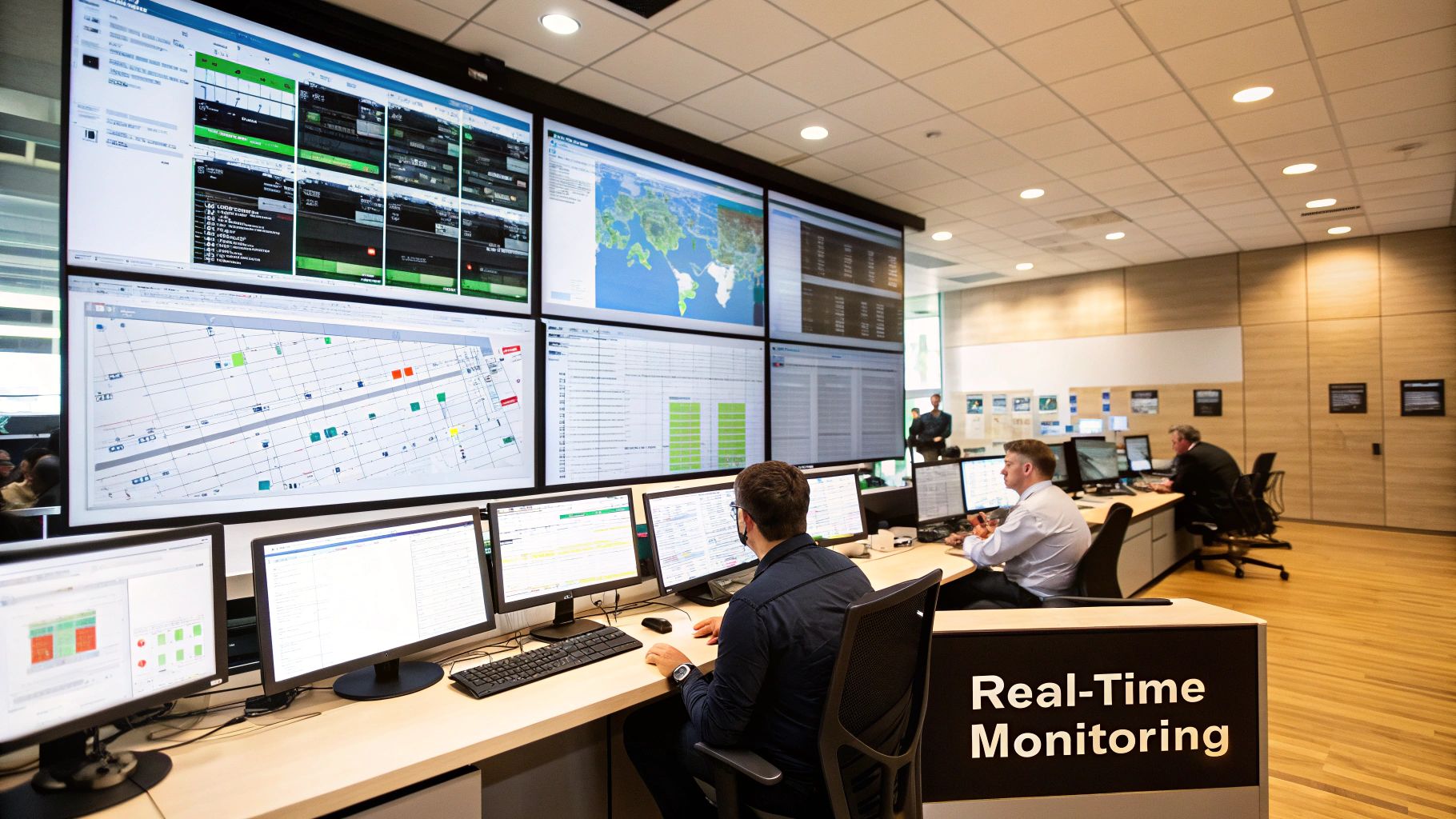Tired of logistics chaos? Our guide to supply chain disruption management offers real-world strategies to build resilience and keep your freight moving.

Let's talk about supply chain disruption management. In simple terms, it's how your business spots, reacts to, and bounces back from those unexpected events that throw a wrench in the works. It’s all about having a plan B (and C, and D) ready to go, so you can keep financial hits to a minimum and your customers happy. The end game? Building an operation that’s tough enough to handle anything from a small hiccup to a full-blown crisis.

If you feel like you're constantly putting out fires in your supply chain, you're not alone. Welcome to the new reality of logistics, where disruptions are no longer a rare "if" but a constant "when." Today's global networks are so interconnected that a single problem in one corner of the world can create a domino effect that impacts everyone.
The things shaking up modern supply chains are complex and often feed into one another. We've all seen how major global events can bring ports to a standstill, but there are countless other pressures bubbling under the surface every single day. These aren't just abstract issues—they hit your bottom line directly, affecting freight costs, delivery schedules, and how much inventory you have to keep on hand.
It's tempting to point fingers at a single cause, but the truth is, the fragility we're seeing is built into the system. It’s a result of several powerful, long-term trends. Getting a handle on these root causes is the first real step toward building a more resilient operation.
Here are the big ones I see affecting businesses day in and day out:
A single disruption can have a cascading effect. For instance, a port strike on one coast can increase demand—and prices—for trucking capacity across the entire country as companies scramble to reroute their freight.
Here's a quick look at major disruption types and how they can affect your costs, deliveries, and inventory.
These scenarios aren't hypothetical; they're happening right now. Proactive planning is the only way to stay ahead.
Trade policy, in particular, has become a massive driver of supply chain change. When governments impose new tariffs, like duties of up to 25% on certain imports, it can add millions to a company's annual costs.
In fact, one study found that around 60% of U.S. companies saw their logistics costs jump by 10% to 15% due to recent tariffs. You can read more about how tariffs are reshaping global supply chains and see just how deep the impact goes.
This is exactly why having a plan is no longer a "nice-to-have"—it's a core business function. Building a truly resilient operation means having a comprehensive supply chain risk management strategy in place.

The best way to handle a supply chain disruption is to see it coming long before it hits your loading dock. This is all about making a mental shift—moving away from just tracking shipments that are already late and toward proactively spotting potential threats on the horizon.
Building an "early warning system" isn't as complicated as it sounds. It's really about creating a practical, data-driven plan that helps you anticipate problems instead of just reacting to them. The first step? Figure out which Key Risk Indicators (KRIs) actually matter to your business and your specific shipping lanes. You can't monitor everything, so you have to be strategic.
Think of your KRIs as the vital signs for your supply chain's health. They’re the little clues that hint at a bigger problem brewing, giving you that precious time to make a change.
To get started, map out your most critical freight routes and where your key suppliers are. From there, you can start to identify the weak points.
Some powerful, yet often overlooked, indicators include:
An effective early warning system turns raw data into actionable intelligence. Knowing a storm is coming is one thing; knowing which three LTL shipments need to be rerouted and which customers to notify is what truly builds resilience.
Data and tech are fantastic tools, but don't ever underestimate the human element. Your suppliers, carriers, and 3PLs are your eyes and ears on the ground. When you build open, transparent communication, they stop being simple vendors and become genuine partners who can give you invaluable early warnings.
The COVID-19 pandemic threw this reality into sharp focus. An analysis from the Federal Reserve Bank of Richmond shows how global supply chain pressures shot through the roof in early 2020 as lockdowns brought production to a halt. It was a painful lesson in why we need strategies to handle global crises, and strong partner communication is the bedrock of that resilience.
When your partners feel like they're on your team, they're far more likely to give you a heads-up about a potential material shortage or a local capacity crunch—long before it shows up as an official delay in the system. That kind of proactive dialogue is one of the most powerful layers you can add to your early warning system.
When a disruption hits, having a solid plan is what separates a controlled pivot from costly chaos. A good supply chain disruption management playbook isn't some rigid, hundred-page document that gathers dust on a shelf.
Think of it instead as a flexible framework that empowers your team to act decisively and quickly. The goal is agility—knowing exactly what to do the moment things go sideways.
An effective response playbook is really about mapping out your alternatives before you need them. It's about having pre-vetted backup transportation routes, alternate suppliers, and emergency inventory plans ready to go.
For example, what happens if your primary LTL carrier has a regional shutdown because of a hurricane? Your playbook should immediately point you to the contact info for your secondary and tertiary carriers for that lane. No scrambling, just action.
The process flow below really highlights the core pillars of building this kind of proactive strategy.

As you can see, a powerful response begins long before the crisis. It all starts with identifying risks and developing a strategy before you ever have to put a plan into motion.
I've seen this happen time and again: one of the biggest points of failure during a disruption isn't the lack of a backup plan—it's confusion over who is supposed to actually do it.
Your playbook absolutely must clearly define roles and responsibilities.
The best playbooks I’ve worked with include simple checklists and communication templates. This removes the guesswork and ensures everyone, from the warehouse floor to the C-suite, knows their role and has the information they need to get it done.
Having these logistics nailed down is just a core component of strong operational health. You can explore more ways to stay ahead by reviewing these supply chain management best practices that top companies rely on.
Ultimately, a good response plan gives your team confidence. It turns panic into a structured, measured reaction, allowing you to protect your bottom line and, most importantly, maintain customer trust. Sometimes, that means needing to find a new LTL or FTL freight option at a moment's notice.

Trying to run a modern supply chain without the right technology is like trying to drive through a new city at night with no map and no headlights. You might get there eventually, but it’s going to be a stressful, inefficient mess. Technology is what cuts through the fog, giving you a clear, real-time picture of your entire operation so you can make smart, fast decisions when things go wrong.
The real aim here isn't just about tracking a package. It's about creating a single, reliable hub of information for your whole network. When you can see everything in one place—from inventory sitting in a partner’s warehouse to the exact location of a full truckload heading to a major client—you stop playing defense and start calling the shots.
This isn't just a nice-to-have anymore. A recent study revealed that 82% of supply chain organizations have boosted their IT budgets. They're pouring money into AI and real-time visibility because they know it's the only way to build an operation that can handle surprises. You can dig into these supply chain spending trends and find additional statistics to see just how seriously the industry is taking this shift.
Real-time visibility platforms have been a total game-changer. These aren't your grandfather's tracking numbers. We're talking live GPS data for both your FTL and LTL shipments, letting you see precisely where your freight is on a map, whether it's moving, and what its ETA is—updated by the minute.
This live feed means you're the first to know about a potential delay. Picture this: a truck carrying your urgent shipment hits a surprise highway closure. With real-time visibility, you know immediately. You can get on the phone with your customer to manage their expectations and start looking at backup plans before a minor hiccup turns into a major crisis.
If visibility tells you what’s happening now, predictive analytics is your crystal ball for what might happen next. These incredibly smart tools sift through mountains of data to flag potential problems long before they actually disrupt your flow.
They look at all kinds of patterns, including:
Think of it like a weather forecast for your supply chain. It gives you the insight to reroute a shipment before it gets caught in the storm, not while it's in the middle of it.
This foresight completely flips the script on risk management. You shift from constantly putting out fires to strategically steering clear of them in the first place. That’s how you keep freight moving, costs down, and customers happy.
We've all heard the old saying, "Don't put all your eggs in one basket." In today's volatile logistics world, that’s not just folksy wisdom—it's a core survival strategy. Relying on a single supplier for a critical part or using just one shipping route is a massive gamble. One hiccup, and your entire operation can grind to a halt.
Building a truly resilient supply chain is all about diversification. The goal is to design a network with built-in redundancies, so no single event—a factory fire, a port strike, or a sudden storm—can trigger a catastrophic failure. It’s about having a Plan B, C, and D ready to go before you ever need them.
https://www.youtube.com/embed/qeadkAL5YwY
Adding new suppliers can feel like a huge undertaking, but it's one of the most powerful moves you can make for your supply chain disruption management plan. This isn't about ditching your trusted partners. Instead, think of it as building a bench of secondary or even tertiary sources you can call on when things go sideways.
A great place to start is with nearshoring—finding suppliers closer to home. For many companies, this has meant looking to Mexico. This simple shift can dramatically shorten transit times, trim transportation costs, and open up more freight options like rail and truck, reducing your dependence on ocean shipping.
When you're vetting potential new partners, really dig into these areas:
Your supplier network is only half the battle. You also need to get creative with how your goods actually get from point A to point B. If you rely on just one national carrier for all your FTL and LTL freight, you’re leaving yourself vulnerable to their labor issues or capacity shortages.
A resilient logistics network is like a well-designed road system. If the main highway is closed, there are plenty of alternate routes to get you to your destination with minimal delay.
Building this kind of flexibility means cultivating relationships with a mix of carriers. Having a blend of national and reliable regional carriers is a smart play. The regional folks often have a much better pulse on local conditions and can provide more agile service within their specific territories.
It's also a good idea to have backup ports on standby in case your primary gateway gets jammed. This proactive approach is a cornerstone of any solid transportation risk management framework. When disaster strikes and your main freight lane is blocked, having a pre-vetted backup carrier on speed dial is what keeps your products moving and your customers happy.
We’ve gone deep on how to manage supply chain disruptions, but I know it's one thing to talk strategy and another to act when the pressure is on. Let's tackle three of the most common questions I hear from people in the thick of it.
The very first thing you need to do is communicate and assess. Don't panic. Before you make a single move, get a clear picture of what’s happening.
The moment you learn about a major problem—a key supplier's factory goes offline, a port suddenly closes, a freak weather event shuts down a major highway—your priority is to get everyone on the same page. Start calling your suppliers, your carriers, and your own internal teams in sales, production, and customer service. Find out what they know, right now.
At the same time, you have to figure out how bad the damage is. How many of your FTL or LTL shipments are caught in the mess? What’s the most realistic estimate for the delay? What’s the potential hit to your bottom line? Answering these questions lets you activate the right part of your contingency plan instead of just reacting.
Good news: you don't need a Fortune 500 budget to build a tougher supply chain. For smaller businesses, it’s all about focusing on low-cost, high-impact moves.
Think of your disruption plan as a living document, not a "set it and forget it" file that gathers dust on a server. It needs regular care to stay useful.
You should give it a full review at least annually.
But here’s a pro tip: the absolute best time to review your plan is right after you’ve dealt with a disruption. Do a quick post-mortem. What worked? What fell apart? Were our backup contacts still good? Did our communication flow smoothly?
You should also pull the plan out for a refresh anytime your business makes a big change, like adding a new international supplier, expanding into a new market, or launching a completely different product line. These changes introduce new risks, and your plan needs to account for them.
At FreightQuotesNow, we know that having reliable freight options is the cornerstone of a resilient supply chain. Our platform gives you immediate access to a network of vetted FTL and LTL carriers, letting you find solid backup options in minutes when it used to take hours. See how we can help you stay ahead of the next disruption by getting your free quote today.